Pluggable Optical Transceivers Continue to Evolve
System engineers must balance priorities of reach, thermal management, panel density, backward compatibility, power consumption, multiple sourcing, and cost when selecting optical transceivers.

Pluggable I/O transceivers in standardized configurations have proven to be a cost-effective solution to the challenges of creating high-speed optical networks. They have emerged as a leading interface for current and next-generation network equipment that ranges from current 100 Gb/s to emerging 400 Gb/s and anticipated 800 Gb/s and 1.6 Tb/s switches. Modules can easily be replaced or upgraded at any time during their service life, which gives the operator a great degree of flexibility. Optical modules are available to support multiple signaling protocols, with the most current pluggables featuring 400 Gb coherent optical transmission. System engineers must balance priorities of reach, thermal management, panel density, backward compatibility, power consumption, multiple sourcing, and cost when selecting optical transceivers.

These factors have been stimulating the ongoing development of pluggable modules that are capable of increased bandwidth and reach while minimizing energy usage. Interest is also growing in alternative co-packaged optics (CPO) technology.
The first generation of small form factor pluggable (SFP) specification, SFF INF-8074i, was released in 2001 by the Small Form Factor Committee and defined a 100 Mb/s pluggable device. Design flexibility as well as future upgradeability made the SFP an instant hit.
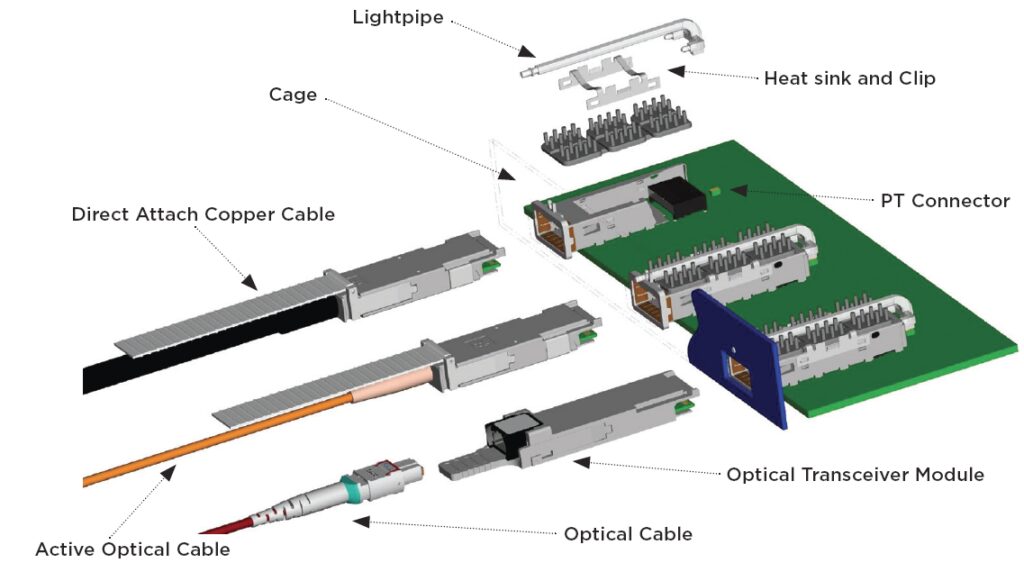
SFP printed circuit board cage receptacles feature the unique ability to accept transceiver modules that are designed to mate with optical cable, active optical cable, as well as passive and active direct attached copper cables.
SFPs continued to evolve and dominate the network industry as they were constantly upgraded with the introduction of 10 Gb SFP+, 25 Gb SFP28, and 50 Gb SFP56. Each of these iterations provide one or two bi-directional multigigabit channels in the same envelope as the original SFP.
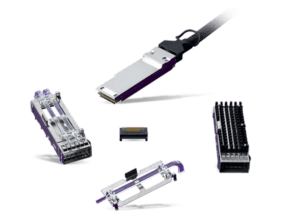
The next step in this evolution was the development of the quad small form factor pluggable (QSFP) in 2006. The objective was to support higher port density applications where limited real estate on the front panel caps the number of ports possible. The original QSFP was a full duplex optical and copper solution featuring four 1 Gb independent transmit and receive channels which can replace up to four single channel SFP connectors.
QSFP+ bumped up the speed to 10 Gb per channel bringing the aggregate bi-directional bandwidth to 40 Gb/s. The transceiver module accepts fiber cables which are terminated with LC or 12 fiber MPO connectors that plug into the rear of the module. This dramatic increase in capacity is packaged in an envelope approximately 30% larger than the standard SFP. Stacked and ganged cages with enhanced EMI springs greatly improved port density and noise isolation. Similar to the evolution of SFP, QSFP28 bumped the aggregate speed to 50 Gb and 100 Gb, QSFP56 enabled aggregate speed to 200 Gb.
Network providers today are facing multiple challenges that are driving adoption of next generation optical interfaces including:
- Faster adoption of new technology and innovation
- Need to launch new services to increase revenue
- Dependance on single source vendors
- Increase in network capacity and reliability
- Integrating network automation
- Reducing power consumption
Two new pluggable interfaces, QSFP-Double Density (QSFP-DD) and Octal SFP (OSFP), provide eight duplex channels operating at up to 50 Gb/s each to deliver 400 Gb performance.
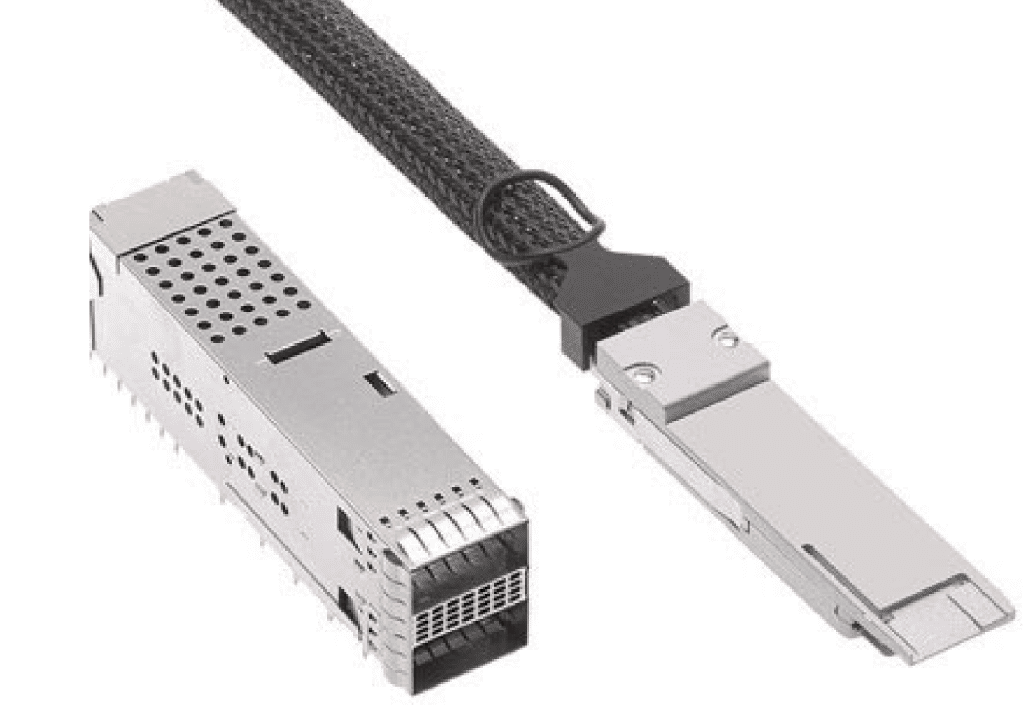 The QSFP-DD is a module and cage/connector system being promoted by the QSFP-DD MSA that quadruples the signal density of standard QSFP 28. QSFP-DD, is the smallest form factor for 400G transceivers, offering the industry’s highest bandwidth density while leveraging the backward compatibility to lower-speed QSFP pluggable modules and cables. The QSFP-DD 5.1 specification features the same profile as the standard QSFP, envelope but with an additional row of contacts.
The QSFP-DD is a module and cage/connector system being promoted by the QSFP-DD MSA that quadruples the signal density of standard QSFP 28. QSFP-DD, is the smallest form factor for 400G transceivers, offering the industry’s highest bandwidth density while leveraging the backward compatibility to lower-speed QSFP pluggable modules and cables. The QSFP-DD 5.1 specification features the same profile as the standard QSFP, envelope but with an additional row of contacts.
This enables an eight-lane electrical interface with each channel operating at 25 Gb/s NRZ or 50 Gb/s PAM4 to deliver 400 Gb/s, with reach up to 2 km.
Standard QSFP modules can be plugged into the QSFP-DD PCB cage which are available in single, ganged, and stacked configurations. Modules draw a maximum of 12 watts.

Integrated heat sinks applied to the exterior of the cage are required to dissipate heat generated by optical modules.
QSFP-DD cable reach can range from 3 m of passive copper cables, 100 m of parallel multimode fiber, 500 m of parallel single mode fiber, and up to 2 km over duplex single-mode fiber. Amphenol Communications Solutions recently announced their 400G QSFP-DD SR8 16 lane optical transceiver that transmits 53.125 Gb/s over each channel.
The QSFP-DD 800 Multi Source Agreement was formed to advance the development of high-speed, QSFP-DD modules to support 800 Gb/s connectivity. The MSA, which includes input from members Molex and Samtec Inc., recently released a new hardware specification for the QSFP-DD 800 transceiver which enables 8 x 100 Gb/lane performance. The MSA also added QSFP112 electrical and management timing specifications including updated power supply test methods and support for an increased module power rating to 25 W.
Octal Small Form Factor Pluggable (OSFP) connectors are another recent contender targeting 800 Gb applications in next-generation data centers, campuses, and other mid-range reach applications.
are another recent contender targeting 800 Gb applications in next-generation data centers, campuses, and other mid-range reach applications.
This pluggable optical transceiver features integrated open or closed top heat sink fins as well as ventilation holes as defined in the specification. Modules are designed to manage up to 15 watts per port.
OSFP modules are similar to the performance and profile of QSFP-DD modules but differ in several ways. OSFP connectors are slightly wider and deeper than the QSFP profile consuming more precious PCB space. Up to 32 OSFP ports can be mounted on a line card where 36 QSFP-DD modules can be installed in the same space. OSFP optic modules consume up to 15 watts, as opposed to 12 watts for QSFP-DD. OSFP modules feature integrated heat sinks on the module. Both interfaces provide 8 channels at up to 50 Gb/s to satisfy current 400 Gb/s data rate demands. The OSFP MSA roadmap includes OSFP 112 G modules and cages providing system engineers with an 8 x 112 G PAM4 interconnect solution to support data transfer in next generation 800 Gb high-density data center and cloud computing applications with reach up to 80 km in length. OSFP 112 PAM4 optical modules have already entered the market.
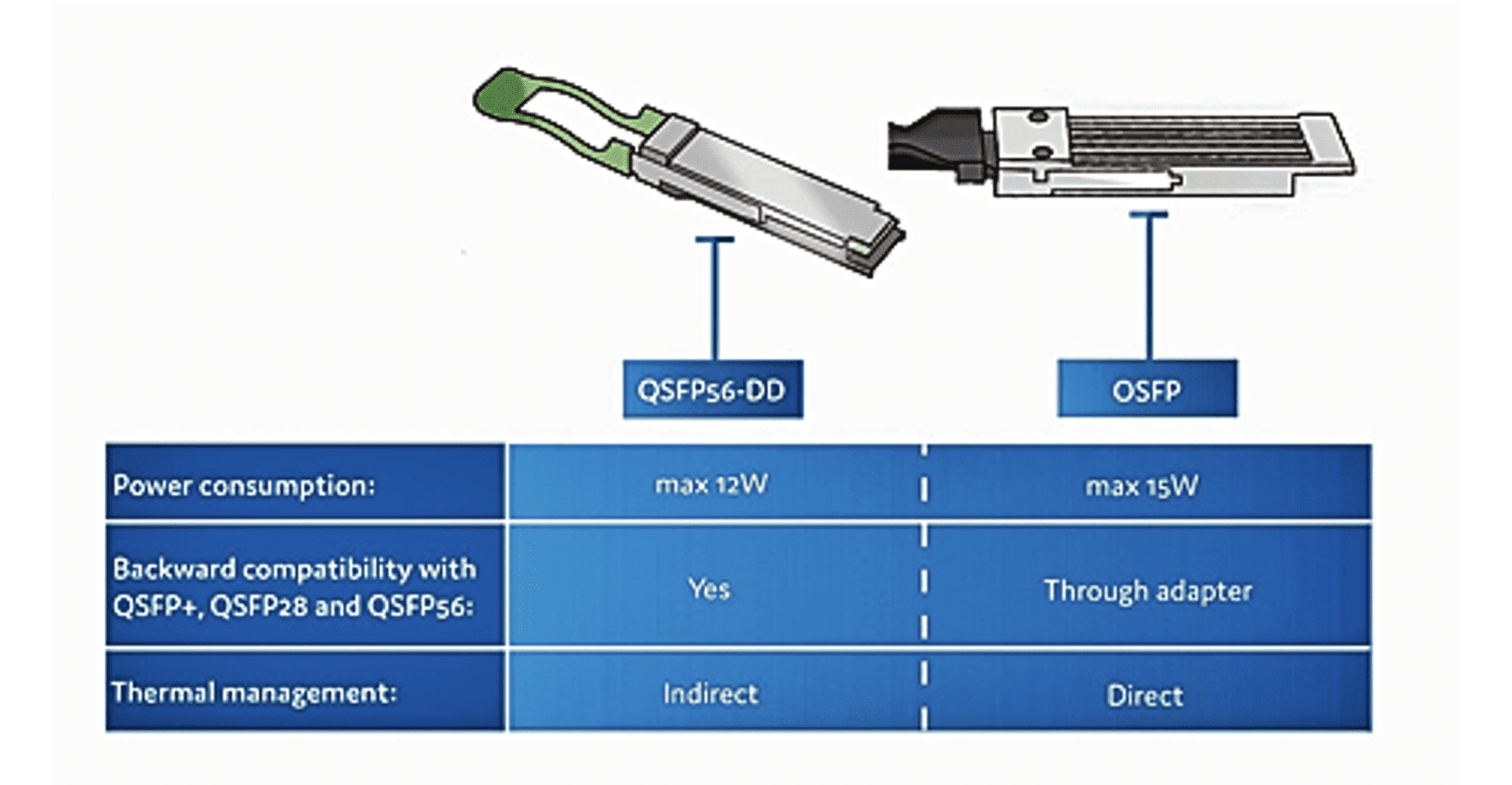
The roadmap of pluggable optical modules continues to be extended in support up to 200 Gb/s per lane channels capable of 1.6 Tb/s total bandwidth in a 200 Gb X8 configuration.
Major advances in chip fabrication including 3 nm and 5 nm devices have begun to put pressure on the ability of current pluggable I/O transceivers to support the anticipated bandwidth density and thermal limitations of next generation switch SERDES.

Forecasts indicate that the bandwidth capacity of next-generation switches may exceed the available faceplate space on a 1RU form factor switch using current pluggable module form factors.
With switch bandwidth doubling approximately every two years, faceplate density will likely become a serious data bottleneck.
A recent addition to the roster of pluggable optical transceivers is a proposal of a 2 x 8 lane electrical interface OSFP-XD (extra dense) pluggable module which is designed to address this challenge. The 4X 400G MSA has proposed this concept as providing a path to a 1.6 Tb pluggable optical transceiver operating at 100 Gb per lane to support future generation 51.2 Tb switches. Upgraded 200G SERDES would enable development of 3.2 Tb switches.
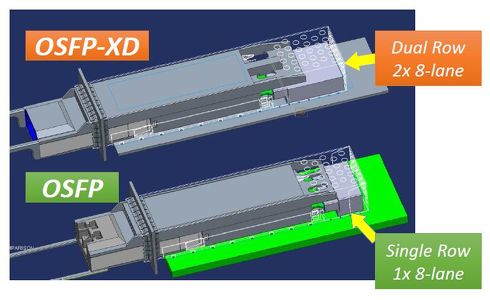 The OSFP-XD module features 16 optical channels and would hopefully be backward compatible with existing OSFP pluggables while offering the same faceplate connector density and doubling the signal density. The ability to support large capacity switches in a 1RU profile is highly desirable.
The OSFP-XD module features 16 optical channels and would hopefully be backward compatible with existing OSFP pluggables while offering the same faceplate connector density and doubling the signal density. The ability to support large capacity switches in a 1RU profile is highly desirable.
The OSFP MSA recently published a white paper outlining a 1.6 Tb density pluggable with 16 lanes at 100 Gb/s and a future iteration featuring 16 lanes at 200 Gb/s delivering 3.2 Tb density. OSFP-XD is currently in the development stage but has support from several hyperscalers making it likely to enter the market with multiple suppliers. The formal OSFP-XD specification is expected to be released in 2023. OSFP-XD is considered a possible alternative to co-packaged optics, but co-existence is a more likely scenario.
There is little doubt that more users will be accessing the internet for work and play as more of our lives are digitized. As bandwidth demand continues to grow, hyperscalers and cloud service providers will be required to constantly upgrade their infrastructure. Emerging data center applications including artificial intelligence and machine learning are driving the adoption of 400 Gb and future 800 Gb pluggable coherent optical transceivers.
See Bob Hult’s Tech Trends series to learn more about the evolution of high-speed interconnects.
Like this article? Check out our other Connector Basics articles, our Datacom Market Page, and our 2022 and 2023 Article Archives.
Subscribe to our weekly e-newsletters, follow us on LinkedIn, Twitter, and Facebook, and check out our eBook archives for more applicable, expert-informed connectivity content.
- Optics Outpace Copper at OFC 2024 - April 16, 2024
- Digital Lighting Enhances your Theatrical Experience - March 5, 2024
- DesignCon 2024 in Review - February 13, 2024





